 What if instead of just taking dorky pictures of your friends you could use your camera phone as an image swab, culling visual samples of the world around you and plugging them into a global database? Every transmitted picture would then be cross referenced with the global image bank and come back with information about what you just shot. A kind of “visual Google.”
What if instead of just taking dorky pictures of your friends you could use your camera phone as an image swab, culling visual samples of the world around you and plugging them into a global database? Every transmitted picture would then be cross referenced with the global image bank and come back with information about what you just shot. A kind of “visual Google.”
This may not be so far away. Take a look at this interview in TheFeature with computer vision researcher Hartmut Neven. Neven talks about “hyperlinking the world” through image-recognition software he has developed for handheld devices such as camera phones. If it were to actually expand to the scale Neven envisions (we’re talking billions of images), could it really work? Hard to say, but it’s quite a thought – sort of a global brain of Babel. Think of the brain as a library where information is accessed by sense (in this case vision) queries. Then make it earth-sized.
Here, in Neven’s words, is how it would work:
“You take a picture of something, send it to our servers, and we either provide you with more information or link you to the place that will. Let’s say you’re standing in front of the Mona Lisa in the Louvre. You take a snapshot with your cameraphone and instantly receive an audio-visual narrative about the painting. Then you step out of the Louvre and see a cafe. Should you go in? Take a shot from the other side of the street and a restaurant guide will appear on your phone. You sit down inside, but perhaps your French is a little rusty. You take a picture of the menu and a dictionary comes up to translate. There is a huge variety of people in these kinds of situations, from stamp collectors, to people who want to check their skin melanoma, to police officers who need to identify the person in front of them.”
But the technology has some very frightening implications as well, chief among them its potential for biometric human identification through “iris scanning and skin texture analysis.” This could have some fairly sensible uses, like an added security layer for banking and credit, but we’re dreaming if we think that will be the extent of it. Already, the Los Angeles Police Department is testing facial recognition programs based on Neven’s work – a library of “digital mugshots” that can be cross referenced with newly captured images from the street. Add this to a second Patriot Act and you’ve got a pretty nasty cocktail.
Monthly Archives: January 2005
the digital aesthetic: what are we losing?
Much as I love most things digital, I occassionally come across an example of how lacking the virtual still is in comparison to the material. A recent staged showdown between a traditional oil painter and a digital “painter” makes this all too clear. Somehow the digital “painting” just doesn’t have the same vitality as the old-fashioned brush and paint version. Compare, which do you think is better?
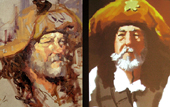
I think there is some equivalent for books, but only for really fine books with delicious velvety (or thick toothy) paper, elegant typography, masterful craftsmanship. In short, the book as art object has the kind of appeal that probably will not be userped by its digital counterpart. However, there is a certain excitement to live, electric, dynamic, cinematic, interactive digital media that traditional forms can’t compete with. Maybe the mistake of this “showdown” was to ask digital art to try to be traditional oil painting and what’s the point of that?
One more thing, I will never give up my gorgeous Lynd Ward books, but if a digital version came along full of annotations, images of Ward at work, video or audio clips, biographical information, links to other fans of Ward, etc… I would buy it in a heartbeat.
elegant map hack
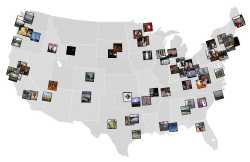 i’m not sure how i missed it till now, but until two days ago i’d never heard of Flickr (the photo management tool and community). now i’ve seen at least a dozen references in the past 24 hours. the most recent is Mappr, a wonderfully elegant hack from Mike Migurski and Eric Rodenbeck of Stamen Design who have used the information people tag their photos with to make a real-time map of recent photos posted to Flickr.
i’m not sure how i missed it till now, but until two days ago i’d never heard of Flickr (the photo management tool and community). now i’ve seen at least a dozen references in the past 24 hours. the most recent is Mappr, a wonderfully elegant hack from Mike Migurski and Eric Rodenbeck of Stamen Design who have used the information people tag their photos with to make a real-time map of recent photos posted to Flickr.
makes me think about the possibility of a real-time “community of readers” which allows you to see everyone in the world who is reading the same electronic document you are (assuming they have “opted-in” and allowed their names to be public).
top selling ebooks of 2004 announced
 Though still tiny, the ebook industry has been growing steadily since everyone pronounced its stillbirth a few years back. But right now it pretty much tracks the print figures – a faint, crackling aura around the print goliath. Pretty predictable stuff. I say it’s time for something new, for something born digital, to occur…
Though still tiny, the ebook industry has been growing steadily since everyone pronounced its stillbirth a few years back. But right now it pretty much tracks the print figures – a faint, crackling aura around the print goliath. Pretty predictable stuff. I say it’s time for something new, for something born digital, to occur…
The Open eBook Forum (OeBF) announced the bestselling electronic titles of 2004 (press release) and reported double digit growth for the fledgling industry. Sci-fi, reference books, and the work of Dan Brown (who holds places 1 through 4) figure prominently on the top 30 list, along with a smattering of other print bestsellers. (yawn)
the ideal device
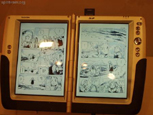


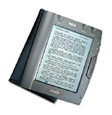
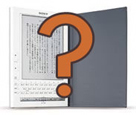
Bob wrote a couple of days ago about the new French Cybook – a sleek, but heavy, new ebook reader. Everyone interested in serious electronic books is waiting for the ideal device to come along, so that screen-based reading will be as comfortable paper-based. The benchmark for most is: “can I take it into bed with me?”  This is a very serious question (people who sleep with their laptops notwithstanding). But my hunch is that these successive generations of reading devices are missing the point. Who wants a device that is just for reading books? I don’t have a bag devoted exclusively to toting paper books. I carry many things together – books, pens, magazines, cds, maps, pictures, food etc. People are already using their cell phones for just about everything.
This is a very serious question (people who sleep with their laptops notwithstanding). But my hunch is that these successive generations of reading devices are missing the point. Who wants a device that is just for reading books? I don’t have a bag devoted exclusively to toting paper books. I carry many things together – books, pens, magazines, cds, maps, pictures, food etc. People are already using their cell phones for just about everything.
I think what we’re waiting for will be descended from laptops. They will likely resemble tablets, or even scrolls. It’s hard to predict. But take a look at this nice post at Word Munger from last year. I think this is on the right track.
Would love to hear some ideas….
lunch with alex itin
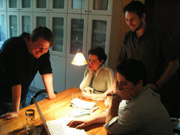


While we wait for our offices at Columbia, the Institute for the Future of the Book is conducting business in Bob Stein’s kitchen on the upper west side of Manhattan. Though our location affords almost limitless opportunities for cuisine, we have, for various reasons, limited our gustatory experience to three restaurants: Saigon Grill, Miyako Sushi, Pizza Perfecto. This limitation makes choosing what to have for lunch both easier and more difficult at the same time, as no one wants to be the one who cries sushi on a clearly Italian sort of day. So we were all glad when Alex arrived to settle the question. Saigon Grill.
Alex also treated us to a viewing of his latest work-in-progress, an electronic book/hybrid artwork entitled “Willoughby.” Alex uses electronic book technology (TK3, to be exact) to cast his black and white drawings as stage sets into which he embeds video clips of his performance. In the clips, he appears in elaborate make-up enacting bits of Willoughby’s tortured monologue (“I don’t want to die,” is Willoughby’s refrain). As Alex pages through the ebook, he casually narrates the story. This narration creates an engaging framework for the piece.
For a full-on Itin experience, you can download his electronic sketchbooks or visit the exhibitions section of our site for a description of his latest work-in-progress. Why are we so interested in his work? Bob, who has known Alex for some time, describes the progression, “When Alex started to bring his work as a painter into the electronic medium, an impulse to combine those images with sound, video, and narrative, quickly emerged and Alex went with it. It’s interesting to watch an artist follow these impulses to invent a new form of expression.”
e-culture report from the netherlands
Recently translated into english, From ICT to E-culture is an “advisory report on the digitalisation of culture and the implications for cultural policy” submitted by the Netherlands Council for Culture in 2003. Survey of the changing landscape..
new ebook sighting (hardware)
 a french company has released a new ebook, the Cybook, which seems to have a decent size-screen (10″ diagonal) and runs most of the e-book software formats.
a french company has released a new ebook, the Cybook, which seems to have a decent size-screen (10″ diagonal) and runs most of the e-book software formats.
but . . . it’s very heavy (2.2 pounds), has a relatively low resolution (72 dpi running at 800×600), won’t be visible outside; doesn’t come standard with wireless connectivity etc.
contrast to the Sony LIbrie which has similar dimensions but is only 1/4″ thick and weighs only 8oz., and uses an e-ink substrate rather than an LED so it is visible even in sunlight. of course the Librie is black and white, doesn’t support video, doesn’t connect to the net etc.
my guess is we’re still a couple of years away from a reading device that people can really get excited about.
what’s a library?
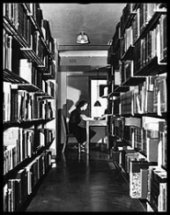 In a recent discussion in these pages, Gary Frost has suggested that the Google library model would be premised on an inter-library loan system, “extending” the preeminence of print. Sure, enabling “inside the book” browsing of library collections will allow people to engage remotely with print volumes on distant shelves, and will help them track down physical copies if they so desire. But do we really expect this to be the primary function of such a powerful resource?
In a recent discussion in these pages, Gary Frost has suggested that the Google library model would be premised on an inter-library loan system, “extending” the preeminence of print. Sure, enabling “inside the book” browsing of library collections will allow people to engage remotely with print volumes on distant shelves, and will help them track down physical copies if they so desire. But do we really expect this to be the primary function of such a powerful resource?
We have to ask what this Google library intitiative is really aiming to do. What is the point? Is it simply a search tool for accessing physical collections, or is it truly a library in its own right? A library encompasses architecture, other people, temptations, distractions, whispers, touch. If the Google library is nothing more than a dynamic book locator, then it will have fallen terribly short of its immense potential to bring these afore-mentioned qualities into virtual space. Inside-the-book browsing is a sad echo of actual tactile browsing in a brick-and-mortar library. It’s a tease, or more likely, a sales hook. I think that’s far more likely to be the way people would use Google to track down print copies – consistent with Google’s current ad-based revenue structure.
But a library is not a retail space – it is an open door to knowledge, a highway with no tolls. How can we reinvent this in networked digital space?
more thoughts on salinas
Instead of becoming obsolete or extinct, local libraries should become portals to the global catalogue – a place where every conceivable text is directly obtainable. Instead of a library card, I might have a portable PC tablet that I use for all my e-texts, and I could plug into the stacks to download or search material. In this way, each library is every library.
But community libraries shouldn’t simply be a node on the larger network. They should cultivate their unique geographical and cultural situation and build themselves into repositories of local knowledge. By being freed, literally, of the weight of general print collections, local branches could really focus on cultivating rich, site-specific resources and multimedia archives of the surrounding environment.
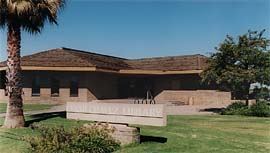 In Salinas, for example, there are two bookshelves of Chicano literature at the Cesar Chavez Library – a precious, unique resource that will soon be inaccessible as libraries close to solve the city’s budget crisis. With all library collections digitized, you wouldn’t have to physically be in Salinas to access the Chicano shelves, but Salinas would remain the place where the major archival work is conducted, and where the storehouse of material artifacts is located.
In Salinas, for example, there are two bookshelves of Chicano literature at the Cesar Chavez Library – a precious, unique resource that will soon be inaccessible as libraries close to solve the city’s budget crisis. With all library collections digitized, you wouldn’t have to physically be in Salinas to access the Chicano shelves, but Salinas would remain the place where the major archival work is conducted, and where the storehouse of material artifacts is located.
It would be a shame for libraries to lose their local character, or for knowledge to become standardized because of big equalizers like Google. But when federal and municipal money is so tight that libraries are actually closing down, can we really expect the digitization of libraries to be achieved by anyone but the big commercial entities (like Google)? And if they’re the ones in charge, can we really count on getting the kind of access to books that libraries once provided? (image: Cesar Chavez Library, Salinas)
